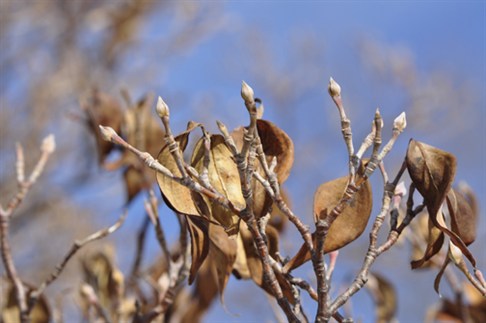Some plants lose their flower buds to the cold during winter.
Sometimes we can see this long before bloom season and be better
prepared at the loss of show. We might also prune a spring blooming
shrub differently when we know it's not going to be contributing to
the spring show.
We've shown you how to look into the bud of a lilac
or a forsythia to see if flowers are
there. Here are a few more examples of such sneak peeks:
Kousa dogwood
Darn, its flower buds are drying up and turning brown.

We sampled buds from several areas of the canopy and found only
buds in this condition, so we think all or most of this dogwood's
blooms are kaput.
This tree, like many kousas in our area, held onto its leaves
last fall. (For more about that, see Leaves hung on.) That can
indicate that a tree was caught short -- not yet finished with the
living process of leaf drop and perhaps also still working on
hardening off when winter descended, killing the leaves while still
attached.


So we won't say it was only the cold that blasted the blooms.
Perhaps it was the cold in addition to the plant's lack of
readiness. Given a fall that progresses more gradually, the tree
may be able to handle cold equal to what it felt this winter,
without losing its bloom.
But this year, we will not expect flowers. We will also thank
the garden gods for leaf tissue that's hardier than flower petals,
even in bud. What a setback it would be for the tree to have to
replace all those leaves.
We may also do some extra watering and fertilizing in this
tree's root zone, with the hope of speedier growth. That's because
all those unclosed openings at the bases of last year's leaves and
the dead flower tissue at the tip of the new shoots may offer leaf
spot fungi an easy opening. The more rapidly the tree's new growth
matures and harden, the more resistant it will be to infection.
Weeping cherry
Cherry flowers form on spurs -- short side shoots off mature
wood. The straight twig at the bottom of the photo
(right), has no spurs. We removed and sliced open buds
from the spurs (below, magnified 10x) to check the
condition of the flowers.
We sampled buds from several branches on the most protected
weeping cherry we know and found that nine out of ten contained the
same dark, decaying mass where a flower should be. Ah, well! We can
hope our State's fruit cherry crop fares better; those trees are
genetically different.

Rhododendron

The big central bud is the rhodie's flower bud. Subtending it
(arrows, photo at right) are the buds that will be the new
branches and leaves.
Most of the rhodies in our area took a severe a hit from the
cold. They lost or will lose many leaves. This setback hit our
local plants even harder since most were only marginally healthy to
begin with in the Midwest's alkaline soil and dry air.
The plants' distress caused us to plan to snap off the flower
buds this year. We think a year without blossoms (they'd look wrong
above such bedraggled plants! ) is acceptable and hope the
flowering energy will be diverted to the plant's overall
recovery.

We'll also prune back hard on some of these plants, to stimulate
foliage development lower and in the interior. (See Deciding what
to cut.)
(Just an aside here: People have occasionally prefaced
conversation with us, "We know you don't like
rhododendrons..."
We'd like to put that rumor to rest. We both love
rhodies. We simply don't like to see them grown in unsuitable
places, and bragged on by people who seem unaware that the plants
could be so much more.)
Silver lining: Here and there rhododendrons did pull through
with little harm (below). Now we are certain of the value
of all that extra attention: Finding them protected places,
fertilizing and watering specially so they could be dense and
healthy enough to weather winter's worst.
Plants with other reasons to
forgo bloom
Sometimes trees and shrubs take a year off after a very heavy
seed production. So much of the plant's energy in that year goes
into the fruit that few flower buds develop.

It's likely that redbud (Cercis canadensis,
right, still loaded with seed), apples and crabapples may
sit this one out or bloom very lightly, having delivered record
breaking crops last fall.
Note the bare branches above the redbud's seedy limbs. Most
of that is last year's new growth, produced post-bloom. Redbud is a
plant that lives up to its reputation for fast growth, even in a
banner year for seed.